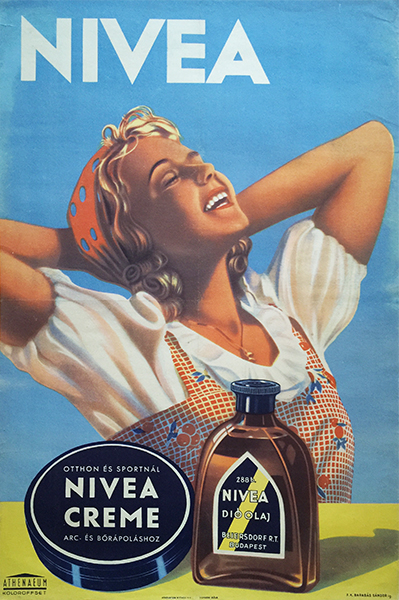
Nivea creme and walnut oil
Hungarian title:
Nivea creme és Nivea dióolaj régi plakát
Artist:
Unknown artist
Size:
Pre-war 1 Sheet (cca. 95 x 63 cm)
Year:
1949
Condition:
Fine, restored, small tears, some creasing, discolouration, micro tears along the border.
Material:
Paper, offset lithography.
Price: US$5000
Description:
Very impressive commercial poster from the last year of the short-lived democracy in Hungary after World War II.
The Nivea brand was founded by Paul Carl Beiersdorf a German pharmasist in 1882 and it took part in imoprtant researches related to medical industry.The name of the brand derives from the latin word 'niveus' which means snow white. Nivea creme was only introduced in 1911 when Oscar Troplowitz, the owner of the Beiersdorf company discovered the first stable water-in-oil emulsifier called eucerin. This revolutionary material does not become rancide unlike the products of the preceeding times. The basic recepie of the lotion is very simple: orange, bergamotte, levander, rose, lilac and lilly of the valley essence is added to the eucerin base and that's it. The range of products started to expand in the 1930s.The brand became an instant success among the wealthy clients in Germany and Austria and soon in the other parts of the world. After the flourishing start of Nivea, in the 1930s due to the Nazi propaganda, the Jewish leaders of the company had to flee. The new leadership was forced to cooperate with the regime but at least the company survived the National Socialist period. However, the ragged fate of the firm did not end in the 1930s. In the Second World War as a result of the severe bombings of the Allied Forces the firm was almost completely demolished and most of the western affiliates disappeared thus it had to regain its international popularity. Today Nivea is among the most popular cosmetic brands being present in more than 200 countries out of which the greatest consumer is the United Arab Emirates.
This poster was made in 1949 when Nivea was already through the hardest times and its popularity in Hungary started to rise again. The decorative posters such as this one greatly contributed to the fact that the famous product managed to restore its international fame. The traditional blue tin on this poster is the 5th version of the Nivea package design and was created in 1935. This design was in use until 1949, but obviously it was only introduced after this poster was made. The first design of the packaging was a yellow tin with Art Nouveau style green and red ornament and in 1924 the famous blue tin with white typography was introduced which was a reaction to the international modernist movement. This design has been in use ever since that time, though with small changes from time to time. On the poster next to the lotion in the blue tin, Nivea Walnut Oil is introduced, which is not in production any more.
In the period after the Second World War and before the Communist system completely took over (1945-1949), after the long politic turmoil of different regimes, the country seemed to take a leftist turn, but attempts to maintain democracy did not disappear. As a result of this situation artists mostly made political posters. Therefore, this poster is one fine example of the rare commercial pieces of the period. However, regardless of the theme, the posters of this era represent a high aritistic value. The style of this poster somewhat resembles the popular art deco style of the 1930s and early 40s with its fine lines, soft shades and elegant shapes but at the same time it also carries the characteristics of the upcoming socialist-realist style of the 1950s.











